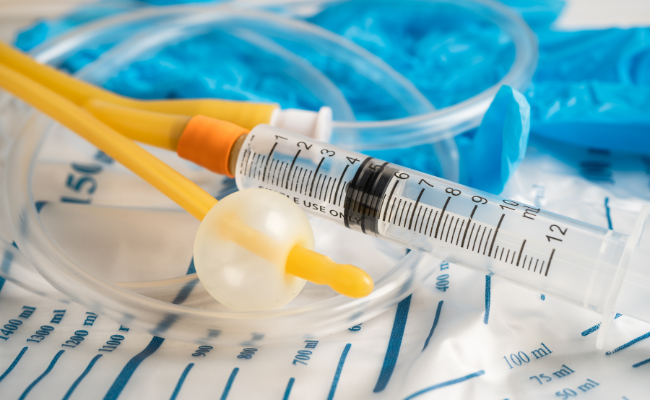Know about Urinary Catheter
- December 26, 2023
- No Comments

What is a Urinary Catheter?
A urinary catheter is a hollow, partially flexible tube utilized for medical purposes, collecting urine from the bladder and directing it into a drainage bag. This flexible tube is inserted into the bladder to facilitate urine drainage, serving as a common medical device when an individual faces challenges in naturally emptying their bladder due to various medical conditions or surgical procedures. Urinary catheters exist in different types, such as indwelling catheters, intermittent catheters, and external catheters, each designed to meet specific patient needs.
Why Use a Urinary Catheter?
The utilization of urinary catheters is prompted by various medical conditions that impact normal bladder function. The key reasons for using a urinary catheter include:
- Urinary Retention: Individuals experiencing urinary retention, a condition where the bladder doesn't empty completely, may require a urinary catheter to ensure efficient drainage and prevent complications.
- Post-Surgical Management: After certain surgical procedures, especially those involving the pelvic region or genitourinary system, patients may experience temporary difficulty in voiding urine. Urinary catheters help manage this postoperative phase by allowing proper urine drainage.
- Bladder Emptying Disorders: Neurological conditions or injuries affecting the nerves controlling the bladder can result in impaired bladder emptying. Urinary catheters provide a means to alleviate the challenges associated with incomplete voiding.
- Incontinence Management: In some cases, urinary catheters are employed as part of a comprehensive approach to managing urinary incontinence. This may be necessary for individuals with complex medical conditions where traditional methods of incontinence management are not sufficient.
How is a Urinary Catheter Inserted?
The process of inserting a urinary catheter involves a series of steps that require precision and adherence to sterile techniques to minimize the risk of infection. The steps for catheter insertion are as follows:
- Preparation: Before the procedure, the healthcare professional ensures a sterile environment and gathers the necessary equipment, including the catheter, lubricating gel, and cleansing solution.
- Patient Positioning: The patient is typically positioned comfortably, often lying down with legs spread apart. For males, the foreskin may be retracted, and for females, the labia may be separated to expose the urethral opening.
- Cleansing: The healthcare provider cleans the genital area with an antiseptic solution to reduce the risk of infection during catheter insertion.
- Lubrication: To facilitate smooth insertion and minimize discomfort for the patient, the catheter's tip is lubricated.
- Insertion: The healthcare provider gently inserts the catheter into the urethra and advances it into the bladder. In cases where an indwelling catheter is used, a small balloon at the catheter's tip is inflated to keep it securely in place.
- Urine Drainage: Once the catheter is in place, urine flows through the catheter into a collection bag, effectively draining the bladder.
Treatment Solution and Alternatives:
While urinary catheters serve as a crucial treatment solution for managing various urinary issues, there are alternatives and considerations based on the specific needs of the patient:
- Intermittent Catheterization: This involves periodically inserting and removing the catheter to empty the bladder. Intermittent catheterization is common for individuals with certain neurological conditions or those who can maintain bladder function with periodic drainage.
- Medications: In some cases, medications may be prescribed to address underlying issues causing urinary retention or incontinence. However, this approach may not be suitable for all patients and conditions.
- Surgical Interventions: Surgical procedures, such as bladder neck suspension or urethral sling placement, may be considered for individuals with specific structural issues contributing to urinary problems.
Benefits of Urinary Catheter Use:
- Effective Bladder Emptying: Urinary catheters ensure effective and complete bladder emptying, preventing complications associated with urinary retention, such as infections and bladder damage.
- Post-Surgical Care: Following certain surgeries, urinary catheters aid in postoperative care by allowing proper monitoring of urine output and minimizing strain on healing tissues. This is crucial for a smooth recovery process.
- Infection Prevention: Properly inserted and maintained urinary catheters can help prevent urinary tract infections by ensuring continuous urine drainage and minimizing the risk of bacterial buildup in the bladder.
- Improved Quality of Life: For individuals with chronic urinary issues, urinary catheters can significantly improve their quality of life. By providing a practical and manageable solution for bladder management, catheters contribute to enhanced comfort and reduced stress.
- Flexibility in Types: Different types of urinary catheters offer flexibility in addressing specific patient needs. Indwelling catheters provide continuous drainage, intermittent catheters allow periodic drainage, and external catheters are suitable for male patients, offering options based on individual requirements.
Comments (0)